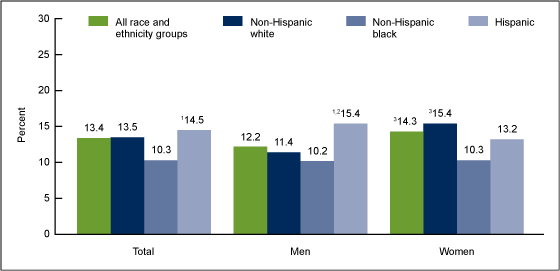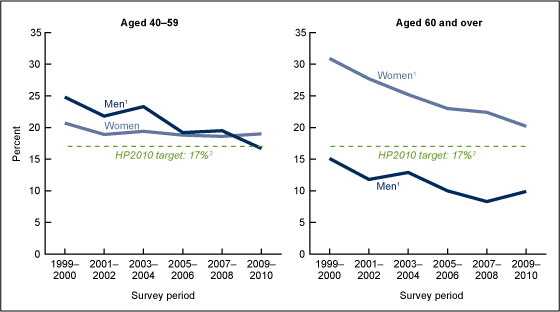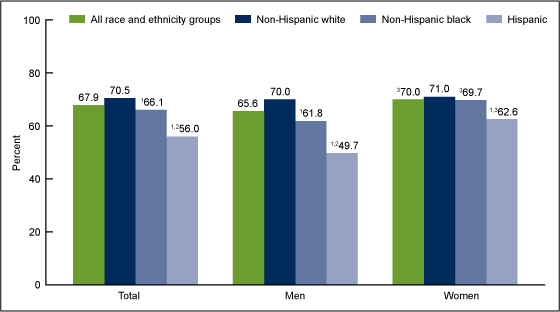Total and High-density Lipoprotein Cholesterol in Adults: National Health and Nutrition Examination Survey, 2009–2010
On This Page
- Key findings
- What percentage of adults aged 20 and over had high total cholesterol during 2009–2010?
- Did the percentage of adults with high total cholesterol change between 1999 and 2010?
- Did trends in high total cholesterol differ by sex and age?
- What percentage of adults had low HDL cholesterol in 2009–2010?
- What percentage of adults had their cholesterol checked within the previous 5 years?
- Summary
- Definitions
- Data source and methods
- About the authors
- References
- Suggested citation
NCHS Data Brief No. 92, April 2012
PDF Version (512 KB)
Margaret D. Carroll, M.S.P.H.; Brian K. Kit, M.D., M.P.H.; and David A. Lacher, M.D., M.Ed.
Key findings
Data from the National Health and Nutrition Examination Survey, 2009–2010
- Just over 13% of U.S. adults had high total cholesterol, meeting the Healthy People 2010 objective of 17% or less for high total cholesterol. However, the objective was not achieved by women aged 40 and over.
- From 1999 through 2010, the percentage of adults aged 20 and over with high total cholesterol declined by 27 percent.
- Approximately 12% of women and 31% of men had low high-density lipoprotein cholesterol in the 2009–2010 survey.
- Overall, more than two-thirds of adults were screened for cholesterol in the preceding 5 years. However, screening rates ranged from 71% in non-Hispanic white women to 50% in Hispanic men. Hispanic men are less likely to be screened than non-Hispanic white or non-Hispanic black men.
High total cholesterol and low high-density lipoprotein (HDL) cholesterol are major risk factors for coronary heart disease, including heart attacks (1–5). To identify persons who may be at risk of developing coronary heart disease, the Adult Treatment Panel of the National Cholesterol Education Program recommends that adults be screened for cholesterol (6). This report presents the most recent prevalence estimates of high total cholesterol, low HDL cholesterol, and cholesterol screening. Trends over the last 12 years for high total cholesterol are also presented. Analysis is based only on measured cholesterol and does not take into account whether medications are taken.
Keywords: cholesterol screening, high total cholesterol, low high-density lipoprotein cholesterol, National Health and Nutrition Examination Survey
What percentage of adults aged 20 and over had high total cholesterol during 2009–2010?
An estimated 13.4% of adults aged 20 and over had high total cholesterol in 2009–2010 (Figure 1). The percentage with high total cholesterol was higher in women (14.3%) than in men (12.2%) and in non-Hispanic white women (15.4%) than in non-Hispanic white men (11.4%).
A larger percentage of Hispanic men had high total cholesterol (15.4%) compared with both non-Hispanic white (11.4%) and non-Hispanic black men (10.2%).
Figure 1. Percentage of adults aged 20 and over with high total cholesterol, by sex and race and ethnicity: United States, 2009–2010
1Significantly different from non-Hispanic black population.
2Significantly different from non-Hispanic white population.
3Significantly different from men in the same racial and ethnic group.
NOTES: High total cholesterol is serum total cholesterol equal to or greater than 240 mg/dL. Estimates were age adjusted by the direct method to U.S. Census 2000 population estimates using age groups 20–39, 40–59, and 60 and over.
SOURCE: CDC/NCHS, National Health and Nutrition Examination Survey, 2009–2010.
Did the percentage of adults with high total cholesterol change between 1999 and 2010?
During 1999–2010, a decreasing trend was observed in the percentage of adults with high total cholesterol (Figure 2). For 1999–2000, 18.3% had high total cholesterol, whereas for 2009–2010, 13.4% had high total cholesterol. Over the 1999–2010 period, men and women showed a decreasing trend in high total cholesterol: 17.2% for men in 1999–2000 compared with 12.2% in 2009–2010, and 19.1% for women in 1999–2000 compared with 14.3% in 2009–2010.
Figure 2. Trends in percentage of adults aged 20 and over with high total cholesterol: United States, 1999–2010
1Significant decreasing trend (p < 0.005).
2Healthy People 2010 Objective (12–14).
NOTES: High total cholesterol is serum total cholesterol level equal to or greater than 240 mg/dL. Estimates were age adjusted by the direct method to U.S. Census 2000 population estimates using age groups 20–39, 40–59, and 60 and over. Access data table for Figure 2 [PDF – 172 KB].
SOURCE: CDC/NCHS, National Health and Nutrition Examination Surveys, 1999–2010.
Did trends in high total cholesterol differ by sex and age?
Among adults aged 40–59, a decreasing trend was observed in the percentage of men with high total cholesterol during 1999–2010, but not for women (Figure 3). For men, the percentage with high total cholesterol declined from 24.8% for 1999–2000 to 16.7% for 2009–2010.
For adults aged 60 and over, a decreasing trend in high total cholesterol was observed in both men and women, with women having consistently higher percentages of high total cholesterol than men.
Figure 3. Trends in percentage of adults aged 40–59 and 60 and over with high total cholesterol: United States, 1999–2010
1Significant decreasing trends (p < 0.005).
2Healthy People 2010 Objective (12–14).
NOTE: High total cholesterol is serum total cholesterol equal to or greater than 240 mg/dL. Access data table for Figure 3 [PDF – 172 KB].
SOURCE: CDC/NCHS, National Health and Nutrition Examination Survey, 1999–2010.
What percentage of adults had low HDL cholesterol in 2009–2010?
For 2009–2010, 21.3% of adults aged 20 and over had low HDL cholesterol (less than 40 mg/dL) (Figure 4). The percentage of adults with low HDL cholesterol was higher for men (31.4%) than for women (11.9%). Percentages among men were also higher than those among women of the same racial and ethnic group. For men, the percentage with low HDL cholesterol was lower among non-Hispanic black men than non-Hispanic white or Hispanic men. No racial or ethnic differences were found among women in the percentage with low HDL cholesterol.
Figure 4. Percentage of adults aged 20 and over with low HDL cholesterol, by sex and race and ethnicity: United States, 2009–2010
1Significantly different from non-Hispanic white population.
2Significantly different from non-Hispanic black population.
3Significantly different from men in each racial and ethnic group.
NOTES: Low HDL cholesterol is serum high-density lipoprotein (HDL) cholesterol less than 40 mg/dL. Estimates were age adjusted by the direct method to U.S. Census 2000 population estimates using age groups 20–39, 40–59, and 60 and over.
SOURCE: CDC/NCHS, National Health and Nutrition Examination Survey, 2009–2010.
What percentage of adults had their cholesterol checked within the previous 5 years?
For 2009–2010, approximately 68.0% of adults aged 20 and over had their cholesterol checked within the preceding 5 years (Figure 5), including almost two-thirds of men (65.6%) and 70.0% of women. For both men and women, non-Hispanic white persons were more likely to have had their cholesterol checked within the past 5 years than Hispanic persons. Non-Hispanic white men were more likely to have been screened than non-Hispanic black men, who themselves were more likely to have been screened than Hispanic men. No difference in screening levels was observed between non-Hispanic white and non-Hispanic black women, nor between non-Hispanic black women and Hispanic women.
Figure 5. Percentage of adults aged 20 and over who had cholesterol checked within past 5 years, by sex and race and ethnicity: United States, 2009–2010
1Significantly different from non-Hispanic white.
2Significantly different from non-Hispanic black.
3Significantly different from men in the same racial and ethnic group.
NOTE: Estimates age adjusted by the direct method to the 2000 Census population using the age groups 20–39, 40–59, and 60 and over.
SOURCE: CDC/NCHS, National Health and Nutrition Examination Survey, 2009–2010.
Summary
The percentage of adults aged 20 and over with high total cholesterol has declined substantially since 1999–2000. For 2009–2010, the percentage of adults with high total cholesterol was 13.4%, thus meeting the Healthy People 2010 target of 17% or less [Objective (12–14)] (7). Substantial and steady decreases in the prevalence of high total cholesterol among men aged 40 and over and women aged 60 and over during the 1999–2010 period resulted in achievement of the Healthy People 2010 objective in all sex and racial-and-ethnic groups and in all sex and age groups except for women aged 40 and over.
For 2009–2010, only 11.9% of women compared with 31.4% of men aged 20 and over had low HDL cholesterol. The percentage with low HDL cholesterol is consistently higher in men than in women within each race and ethnicity group. Because women typically have higher HDL cholesterol levels than men (6), the percentage with low HDL cholesterol is expected to be lower in women than in men. The percentage of adult men with low HDL cholesterol is lower in non-Hispanic black men than in Hispanic or non-Hispanic white men.
During 2009–2010, approximately 68% of adults—including 66% of men and 70% of women—had their cholesterol checked within the past 5 years. These percentages have not changed significantly from 2005–2006, when 65% of men and 71% of women had their cholesterol checked within the past 5 years (8). Furthermore, the Healthy People 2010 objective for cholesterol screening of at least 80% [Objective (12–15)] (7) was not met. Less than one-half of Hispanic men were screened within the past 5 years compared with 70% of non-Hispanic white men and nearly 62% of non-Hispanic black men.
Among U.S. adults in 2009–2010, those with adverse concentrations of total cholesterol (15%) and HDL cholesterol (25%) are at risk for coronary heart disease, including heart attacks. The U.S. Department of Health and Human Services recently announced the Million Hearts Initiative (9) with a goal of preventing 1 million heart attacks and strokes over the next 5 years. High cholesterol is one major risk factor for heart attacks.
Definitions
High total cholesterol: Serum total cholesterol greater than or equal to 240 mg/dL (6).
Low high-density lipoprotein (HDL) cholesterol: Serum high-density lipoprotein cholesterol less than 40 mg/dL (6).
Screened for high cholesterol in the past 5 years: Defined by an affirmative response to the question, “Have you ever had your blood cholesterol checked?” and a response indicating less than 5 years ago to the question, “About how long has it been since you last had your blood cholesterol level checked?”
Healthy People 2010 Objective (12–14): Reduce the proportion of adults with high total blood cholesterol levels. Target: 17% (7).
Healthy People 2010 Objective (12–15): Increase the proportion of adults who have had their blood cholesterol checked within the preceding 5 years. Target: 80% (7).
Data source and methods
Data from National Health and Nutrition Examination Surveys (NHANES) conducted from 1999 through 2010 were used for these analyses. NHANES is a cross-sectional survey designed to monitor the health and nutritional status of the civilian noninstitutionalized U.S. population (10). The survey consists of interviews conducted in participants’ homes; standardized physical examinations conducted in mobile examination centers; and laboratory tests utilizing blood specimens provided by participants during the physical examination. Details on the laboratory methods are available elsewhere (10).
The NHANES sample is selected through a complex, multistage probability design. For survey year 2009–2010, non-Hispanic black and Hispanic persons, persons with low income, and those aged 60 and over were oversampled to obtain reliable estimates of health and nutritional measures for these population subgroups. Data collection is based on a representative sample covering all ages of the civilian noninstitutionalized population. Public-use data files are released in 2-year cycles.
Sample weights, which account for the differential probabilities of selection, nonresponse, and noncoverage, are incorporated into the estimation process. All variance estimates accounted for the complex survey design by using Taylor series linearization.
Prevalence estimates for the total adult population were age adjusted using the direct method to the U.S. Census 2000 population using age groups 20–39, 40–59, and 60 and over. For NHANES 2009–2010, a total of 4,119 interviewed adults reported they had their cholesterol checked within the past 5 years; 5,696 examined adults had data for serum total and HDL cholesterol. Differences between groups were tested using a t statistic with the appropriate number of degrees of freedom at the p < 0.05 significance level. Linear survey trends were tested using orthogonal contrast matrices. All differences reported are statistically significant unless otherwise indicated. The Bonforroni method was used to adjust for multiple comparisons by dividing the overall α level of 0.05 by the number of implied comparisons. To test for race and ethnicity differences for men and for women, three implied comparisons were used. Statistical analyses were conducted using the SAS System for Windows (release 9.2; SAS Institute Inc., Cary, N.C.) and SUDAAN (release 10.0; RTI International, Research Triangle Park, N.C.).
About the authors
Margaret D. Carroll, Brian K. Kit, and David A. Lacher are with the Centers for Disease Control and Prevention’s National Center for Health Statistics, Division of Health and Nutrition Examination Surveys.
References
- Wilson PW, D’Agostino RB, Levy D, Belanger AM, Silbershatz H, Kannel WB. Prediction of coronary heart disease using risk factor categories. Circulation 97(18):1837–47. 1998.
- Lipid Research Clinics Program. The Lipid Research Clinics Coronary Primary Prevention Trial results II: The relationship of reduction in incidence of coronary heart disease to cholesterol lowering. JAMA 251(3):365–74. 1984.
- Stamler J, Wentworth D, Neaton JD. Is the relationship between serum cholesterol and risk of premature death from coronary heart disease continuous and graded? Findings in 356 222 primary screenees of the Multiple Risk Factor Intervention Trial (MRFIT). JAMA 256(20):2823–8. 1986.
- Wilson PW, Garrison RJ, Castelli WP, Feinleib M, McNamara PM, Kannel WB. Prevalence of coronary heart disease in the Framingham Offspring Study: Role of lipoprotein cholesterols. Am J Cardiol 46(4): 649–54. 1980.
- Assmann G, Schulte H, von Eckardstein A, Huang Y. High-density lipoprotein cholesterol as a predictor of coronary heart disease risk: The PROCAM experience and pathophysiological implications for reverse cholesterol transport. Athrosclerosis 124(Suppl):S11–20. 1996.
- National Institutes of Health, National Heart, Lung and Blood Institute. Third report of the National Cholesterol Education Program (NCEP) Expert Panel on Detection, Evaluation and Treatment of High Blood Cholesterol in Adults (Adult Treatment Panel III): Final report. NIH Publication No. 02–5215. 2002.
- U.S. Department of Health and Human Services. Healthy People 2010. 2nd ed. 2 vols. Washington, DC: U.S. Government Printing Office. 2000.
- Schober SE, Carroll MD, Lacher DA, Hirsch R. High serum total cholesterol—an indicator for monitoring cholesterol lowering efforts: U.S. adults, 2005–2006. NCHS data brief no 2. Hyattsville, MD: National Center for Health Statistics. 2007.
- U.S. Department of Health and Human Services. Million Hearts Initiative.
- National Center for Health Statistics. National Health and Nutrition Examination Survey, NHANES 2009–2010.
Suggested citation
Carroll MD, Kit BK, Lacher DA. Total and high-density lipoprotein cholesterol in adults, 2009–2010. NCHS data brief no 92. Hyattsville, MD: National Center for Health Statistics. 2012.
Copyright information
All material appearing in this report is in the public domain and may be reproduced or copied without permission; citation as to source, however, is appreciated.
National Center for Health Statistics
Edward J. Sondik, Ph.D., Director
Jennifer H. Madans, Ph.D., Associate Director for Science
Division of Health and Nutrition Examination Surveys
Clifford L. Johnson, M.S.P.H., Director
- Page last reviewed: November 6, 2015
- Page last updated: April 24, 2012
- Content source:


 ShareCompartir
ShareCompartir




